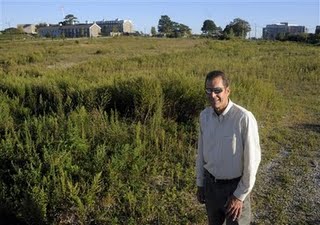Bluegrass Pundit:
Landmark Kelo v. New London
Land Seizure Case Property Now a Vacant Lot
Monday, September 28, 2009
In 2005 the Supreme Court rules 5-4 that local governments could seize private property for nonpublic projects. The landmark care was Kelo v. New London. The town of New London Connecticut wanted to seize Susette Kelo’s home for a multimillion-dollar private development. Kelo, and Americans who value property rights, lost that case. The case resulted in an unsuccessful effort to seize Supreme Court Justice David Souter’s New Hampshire home by eminent domain and build an inn. The 3,169 new jobs and $1.2 million a year in tax revenues promised by New London officials have never materialized. The property is now a vacant lot populated by Feral cats and thistle.
NEW LONDON, Conn. — Weeds, glass, bricks, pieces of pipe and shingle splinters have replaced the knot of aging homes at the site of the nation’s most notorious eminent domain project.
There are a few signs of life: Feral cats glare at visitors from a miniature jungle of Queen Anne’s lace, thistle and goldenrod. Gulls swoop between the lot’s towering trees and the adjacent sewage treatment plant.
But what of the promised building boom that was supposed to come wrapped and ribboned with up to 3,169 new jobs and $1.2 million a year in tax revenues? They are noticeably missing.
Proponents of the ambitious plan blame the sour economy. Opponents call it a “poetic justice.”
“They are getting what they deserve. They are going to get nothing,” said Susette Kelo, the lead plaintiff in the landmark property rights case. “I don’t think this is what the United States Supreme Court justices had in mind when they made this decision.”
Kelo’s iconic pink home sat for more than a century on that currently empty lot, just steps away from Connecticut’s quaint but economically distressed Long Island Sound waterfront. Shortly after she moved in, in 1997, her house became ground zero in the nation’s best-known land rights catfight.
New London officials decided they needed Kelo’s land and the surrounding 90 acres for a multimillion-dollar private development that included residential, hotel conference, research and development space and a new state park that would complement a new $350 million Pfizer pharmaceutical research facility.
Kelo and six other homeowners fought for years, all the way to the U.S. Supreme Court. In 2005, justices voted 5-4 against them, giving cities across the country the right to use eminent domain to take property for private development.
The decision was sharply criticized and created grassroots backlash. Forty states quickly passed new, protective rules and regulations, according to the National Conference of State Legislatures. Some protesters even tried to turn the tables on now-retired Justice David Souter, trying unsuccessfully in 2006 to take his New Hampshire home by eminent domain to build an inn.








